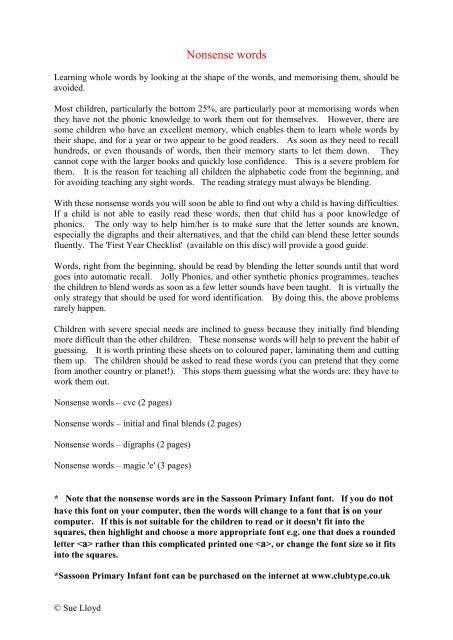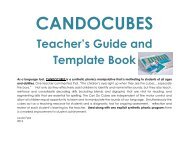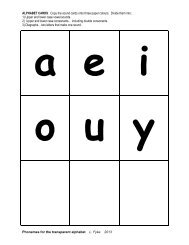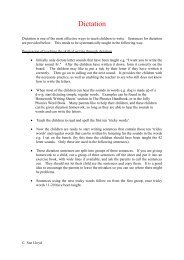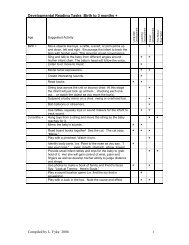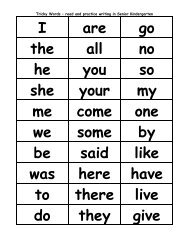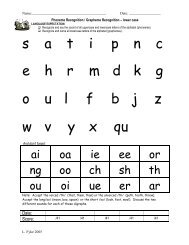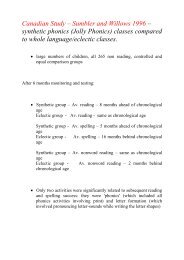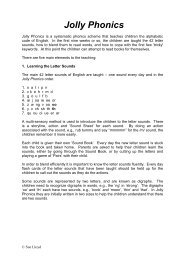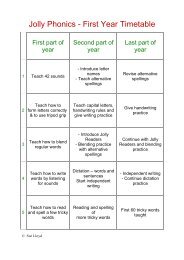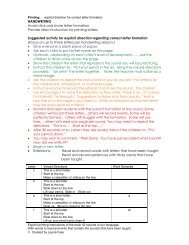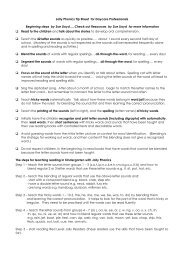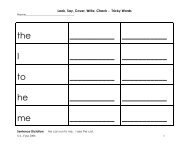Special Needs - Nonsense words.pdf - Primarily Learning
Special Needs - Nonsense words.pdf - Primarily Learning
Special Needs - Nonsense words.pdf - Primarily Learning
You also want an ePaper? Increase the reach of your titles
YUMPU automatically turns print PDFs into web optimized ePapers that Google loves.
<strong>Nonsense</strong> <strong>words</strong><br />
<strong>Learning</strong> whole <strong>words</strong> by looking at the shape of the <strong>words</strong>, and memorising them, should be<br />
avoided.<br />
Most children, particularly the bottom 25%, are particularly poor at memorising <strong>words</strong> when<br />
they have not the phonic knowledge to work them out for themselves. However, there are<br />
some children who have an excellent memory, which enables them to learn whole <strong>words</strong> by<br />
their shape, and for a year or two appear to be good readers. As soon as they need to recall<br />
hundreds, or even thousands of <strong>words</strong>, then their memory starts to let them down. They<br />
cannot cope with the larger books and quickly lose confidence. This is a severe problem for<br />
them. It is the reason for teaching all children the alphabetic code from the beginning, and<br />
for avoiding teaching any sight <strong>words</strong>. The reading strategy must always be blending.<br />
With these nonsense <strong>words</strong> you will soon be able to find out why a child is having difficulties.<br />
If a child is not able to easily read these <strong>words</strong>, then that child has a poor knowledge of<br />
phonics. The only way to help him/her is to make sure that the letter sounds are known,<br />
especially the digraphs and their alternatives, and that the child can blend these letter sounds<br />
fluently. The 'First Year Checklist' (available on this disc) will provide a good guide.<br />
Words, right from the beginning, should be read by blending the letter sounds until that word<br />
goes into automatic recall. Jolly Phonics, and other synthetic phonics programmes, teaches<br />
the children to blend <strong>words</strong> as soon as a few letter sounds have been taught. It is virtually the<br />
only strategy that should be used for word identification. By doing this, the above problems<br />
rarely happen.<br />
Children with severe special needs are inclined to guess because they initially find blending<br />
more difficult than the other children. These nonsense <strong>words</strong> will help to prevent the habit of<br />
guessing. It is worth printing these sheets on to coloured paper, laminating them and cutting<br />
them up. The children should be asked to read these <strong>words</strong> (you can pretend that they come<br />
from another country or planet!). This stops them guessing what the <strong>words</strong> are: they have to<br />
work them out.<br />
<strong>Nonsense</strong> <strong>words</strong> – cvc (2 pages)<br />
<strong>Nonsense</strong> <strong>words</strong> – initial and final blends (2 pages)<br />
<strong>Nonsense</strong> <strong>words</strong> – digraphs (2 pages)<br />
<strong>Nonsense</strong> <strong>words</strong> – magic 'e' (3 pages)<br />
* Note that the nonsense <strong>words</strong> are in the Sassoon Primary Infant font. If you do not<br />
have this font on your computer, then the <strong>words</strong> will change to a font that is on your<br />
computer. If this is not suitable for the children to read or it doesn't fit into the<br />
squares, then highlight and choose a more appropriate font e.g. one that does a rounded<br />
letter rather than this complicated printed one , or change the font size so it fits<br />
into the squares.<br />
*Sassoon Primary Infant font can be purchased on the internet at www.clubtype.co.uk<br />
© Sue Lloyd
ped fut het<br />
lig nazz lon<br />
pell meb dex<br />
zid pab vin<br />
sut fup hoss<br />
pizz lep gax<br />
vit pum biss<br />
mem wid dack<br />
© Sue Lloyd
ub dess rin<br />
tid rop bup<br />
zot tat kizz<br />
mell dip sab<br />
jeg fop dezz<br />
bix jad gom<br />
tam fip yod<br />
sib weg rad<br />
© Sue Lloyd
snex munt brip<br />
frod crot lemp<br />
delp dunt plax<br />
pund twag kest<br />
crut zend spox<br />
lunk blid tran<br />
stod silp grap<br />
snud hent smig<br />
© Sue Lloyd
drit swod twan<br />
jast timp zind<br />
prip kint frot<br />
bant venp plab<br />
veft snop plim<br />
fleb fint dond<br />
yoft swed tont<br />
clen goft wift<br />
© Sue Lloyd
foosh choid<br />
thid<br />
quock whib chan<br />
dooch derb teth<br />
peng thonk quig<br />
whost shart dang<br />
roit hout fook<br />
donk quot thad<br />
oid lang charp<br />
© Sue Lloyd
fipper ching<br />
bart<br />
toud queck lunk<br />
hosh rard habber<br />
woot rooch zarg<br />
shess whud toip<br />
goop ching larb<br />
tong jout zank<br />
booch hoth lersh<br />
© Sue Lloyd
afe mibe wope<br />
fupe lafe tike<br />
cufe mobe wime<br />
sade libe hoke<br />
upe jope nide<br />
lale tibe mude<br />
roke hile gabe<br />
tede cose hime<br />
© Sue Lloyd
smode stupe<br />
grafe<br />
bline slote stribe<br />
plake drofe pripe<br />
flube<br />
stome smipe<br />
trave<br />
swide dwope<br />
prute snoke brize<br />
slofe<br />
crabe dwide<br />
frone swibe clake<br />
© Sue Lloyd
thode<br />
shibe whame<br />
chipe quobe<br />
thafe<br />
thuke quade shote<br />
chike thude thobe<br />
whike thepe chade<br />
thume quife<br />
shafe<br />
shime thabe<br />
chote<br />
thade chipe shate<br />
© Sue Lloyd
© Sue Lloyd


